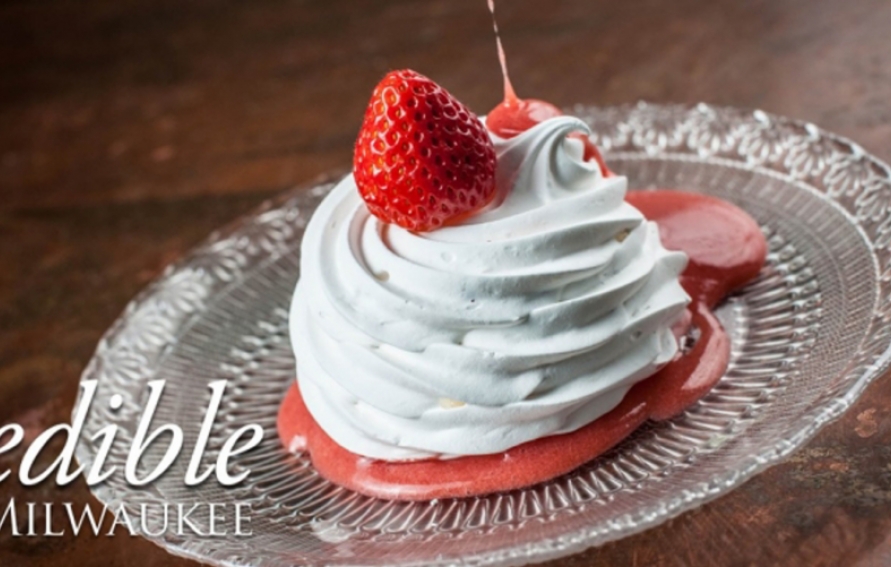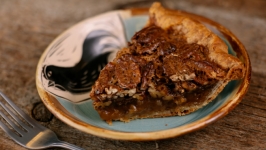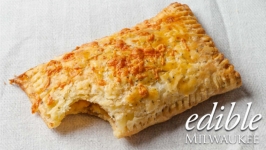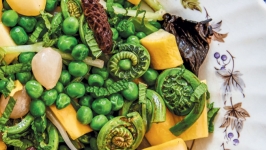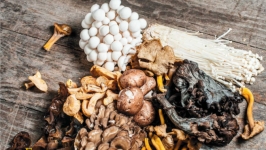“Send him something sweet,” urged Jean Templeton in The Milwaukee Journal on April 17, 1941. Husbands, sons, brothers, and boyfriends away at war craved desserts in addition to their army meals. “Candy, cookies, cake or a surprise schaum torte are among the packable sweets you may mark ‘perishable’ and rush through the mails by air or special delivery.” Packed between thick layers of popcorn, schaum tortes “go through the mail in perfect shape.” And bonus: with real popcorn packaging, the “entire contents of this package is edible.”
Templeton’s suggestion of schaum torte was a true taste of home for soldiers. It’s a Wisconsin favorite, particularly among those of German descent, that few outside the state know.
“I never realized there was anything unique about it until I was an adult,” says Milwaukee native Lori Fredrich, author of Milwaukee Food: A History of Cream City Cuisine. “My grandmother made schaum torte for Easter every year, and ladies sometimes brought it to church potlucks and community events. It was a special occasion food.”
Schaum torte, or sometimes schaumentorten, is German in origin. Its name translates to “foam cake,” an apt description of its meringue base. In Germany, a torte usually refers to a layered cake made with little or no flour. Prepared with little more than egg whites and sugar, schaum torte is typically baked in a springform pan and topped with cream and fruit.
Meringues like schaum torte are familiar desserts in many cultures. It’s closest relative is the more well known pavlova, named for the Russian ballerina Anna Pavlova, though meringue sweets have a much longer history.
Desserts made from sweetened egg whites appear in cookbooks dating back to at least the 17th century. Lady Elinor Fettiplace’s 1604 cookbook included a recipe for “White Bisket Bread” that called for 1½ pounds of sugar, a handful of flour and 12 egg whites, a recipe not unlike that used for meringue today.
Schaum torte may trace its origins to the Spanische Windtorte, often called the “fanciest cake in Vienna” during the height of its popularity in the Austro-Hungarian Empire of the 1600s. Made of cylindrical rings of baked meringue, the complex dessert holds whipped cream and fruit and is traditionally decorated with crystallized or fondant violets. It got its name from the ruling Austrian Hapsburg family, who controlled much of Central Europe between the 15th and 18th centuries, and had a fascination with all things Spanish.
The Wisconsin version likely comes from Germany or Austria, traveling to the United States with immigrants. The Joy of Cooking traces schaum torte back to Wisconsin in the 1870s. It also offered some advice for making it. “If you are cursed with a mental hazard in regard to meringues, dismiss it,” counseled Joy author Irma Rombauer. Milwaukee’s own Lizzie Kander included a recipe for schaum torte, or kiss torte as it also appears to be known, in The Settlement Cookbook.
Although strawberries are common, the fruit topping can vary. In 1973, Milwaukeean Betty Sakar won the National Pineapple Cooking Classic with her “Hawaii Five-O Torte,” a recipe based on schaum torte. Sakar’s tarte called for canned pineapple and lemon pudding. Other versions, like the one served at Pappy’s Bay Shore restaurant, a favorite with Vince Lombardi and Packers players, featured pecans and hot chocolate.
The recipe for schaum torte doesn’t call for many ingredients, but it does require some precision.
Older eggs tend to make the best meringues because the whites are thinner, beating up faster and attracting air quickly. Fresh eggs tend to have thicker egg whites that require more beating to achieve the even viscosity of a perfect meringue.
Sugar is the key to both sweetness and volume. The sugar pulls water from the whites as the proteins recombine around air bubbles. It also helps the beaten whites hold their shape and gives the meringue its distinctive look and texture.
The meringue emerges golden and crusty from the oven. As it cools, the center of the meringue collapses, creating a hollow for berries and cream.
There are two camps with regard to the texture of the meringue: those who like it crispy and dry and those who like it crisp exterior with a marshmallow-soft interior. The difference comes in cooking time and temperature.
“My family lands firmly in the marshmallow-y category,” Fredrich says. “And, as a child, I thought that those little hard disks of meringue were a sign that the torte had been overbaked.”
Lori’s paternal grandmother got the recipe from her aunt, Edna Riebe, although it’s possible that the recipe goes even further back. A favorite dessert, Fredrich made her first schaum torte for prom. Her high school boyfriend loved schaum torte so she made it as an after-prom treat. Her grandmother insisted she borrow her springform pan so it would turn out right.
“I really took on the tradition of making schaum torte in my family,” Fredrich says. “You could even say it launched me on my food trajectory because it was this recipe that I sought to make and preserve.”
Once married, Fredrich made schaum torte for her father-in-law for Father’s Day. Because the meringue requires so many egg whites, leaving a lot of yolks, she began making lemon curd for a topping with the strawberries.
“Schaum torte can be an achingly sweet dessert, so I like how the tart lemon curd cuts through the sweetness,” Fredrich says.
Many people make schaum torte at home or for community events but it can still be found on menus, primarily old-school supper clubs, ethnic restaurants, and steak houses. Karl Ratzch’s serves its schaum torte with strawberries, cream and ice cream. Joey Gerard’s, the Bartolotta Restaurant Group’s modern take on a supper club, features schaum torte as does Alioto’s in Wauwatosa, which opened in the 1920s and features the Alioto family recipe for the dessert.
But that said, schaum torte may be becoming an endangered food.
“Schaum torte is a piece of nostalgia that I think may be fading,” Fredrich says. “It’s still beloved by many people but it is becoming less familiar.”
Fredrich is doing her part to keep schaum torte alive. A few years ago, she entered an adapted version of her grandmother’s recipe in a contest. The recipe won and was featured for a time on the menu of Il Mito in Wauwatosa. Her grandmother, since deceased, was astonished and thrilled that her recipe had inspired this modern version.
“Recipes are meant to be shared. I believe they have a way of developing a life of their own,” Fredrich says. “Sharing my schaum torte recipe is spreading the love to my friends and family. It’s also keeping my German heritage and family baking traditions going.

